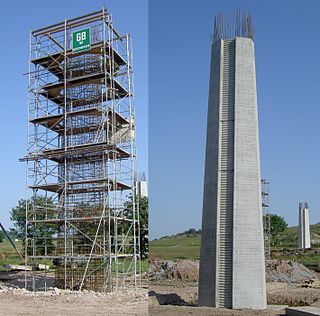
Reinforced concrete (RC), also called reinforced cement concrete (RCC), is a composite material in which concrete's relatively low tensile strength and ductility are compensated for by the inclusion of reinforcement having higher tensile strength or ductility. The reinforcement is usually, though not necessarily, steel bars (rebar) and is usually embedded passively in the concrete before the concrete sets. However, post-tensioning is also employed as a technique to reinforce the concrete. Worldwide, in volume terms it is an absolutely key engineering material. In corrosion engineering terms, when designed correctly, the alkalinity of the concrete protects the steel rebar from corrosion.
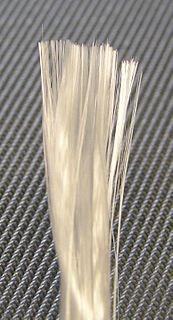
Glass fiber is a material consisting of numerous extremely fine fibers of glass.
Fiberglass, or fibreglass, is a common type of fiber-reinforced plastic using glass fiber. The fibers may be randomly arranged, flattened into a sheet, or woven into glass cloth. The plastic matrix may be a thermoset polymer matrix—most often based on thermosetting polymers such as epoxy, polyester resin, or vinyl ester resin—or a thermoplastic.

A thermoplastic, or thermosoft plastic, is a plastic polymer material that becomes pliable or moldable at a certain elevated temperature and solidifies upon cooling.

Daegu Stadium, also known as the Blue Arc, is a multi-purpose sports stadium located in Daegu, South Korea. It was formerly named Daegu World Cup Stadium but was changed to Daegu Stadium on 5 March 2008. It has a seating capacity for 66,422 people, and parking for 3,550 cars. It is located approximately 11 kilometers or 20 minutes by car from Daegu Airport. It is managed by the Daegu Sports Facilities Management Center.

Building material is material used for construction. Many naturally occurring substances, such as clay, rocks, sand, wood, and even twigs and leaves, have been used to construct buildings. Apart from naturally occurring materials, many man-made products are in use, some more and some less synthetic. The manufacturing of building materials is an established industry in many countries and the use of these materials is typically segmented into specific specialty trades, such as carpentry, insulation, plumbing, and roofing work. They provide the make-up of habitats and structures including homes.

Lamination is the technique/process of manufacturing a material in multiple layers, so that the composite material achieves improved strength, stability, sound insulation, appearance, or other properties from the use of the differing materials, such as plastic. A laminate is a permanently assembled object created using heat, pressure, welding, or adhesives. Various coating machines, machine presses and calendering equipment are used.
Fibre-reinforced plastic is a composite material made of a polymer matrix reinforced with fibres. The fibres are usually glass, carbon, aramid, or basalt. Rarely, other fibres such as paper, wood, or asbestos have been used. The polymer is usually an epoxy, vinyl ester, or polyester thermosetting plastic, though phenol formaldehyde resins are still in use.

A tensile structure is a construction of elements carrying only tension and no compression or bending. The term tensile should not be confused with tensegrity, which is a structural form with both tension and compression elements. Tensile structures are the most common type of thin-shell structures.
Ultra-high-molecular-weight polyethylene is a subset of the thermoplastic polyethylene. Also known as high-modulus polyethylene, (HMPE), it has extremely long chains, with a molecular mass usually between 3.5 and 7.5 million amu. The longer chain serves to transfer load more effectively to the polymer backbone by strengthening intermolecular interactions. This results in a very tough material, with the highest impact strength of any thermoplastic presently made.

Ethylene tetrafluoroethylene (ETFE) is a fluorine-based plastic. It was designed to have high corrosion resistance and strength over a wide temperature range. ETFE is a polymer and its source-based name is poly(ethene-co-tetrafluoroethene). It is also known under the brand name Tefzel. ETFE has a relatively high melting temperature and excellent chemical, electrical and high-energy radiation resistance properties. When burned, ETFE releases hydrofluoric acid.
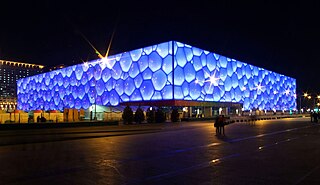
The Beijing National Aquatics Center, officially known as the National Aquatics Center, and colloquially known as the Water Cube and the Ice Cube, is an aquatics center at the Olympic Green in Beijing, China.

Schlaich bergermann partner is a nationally and internationally active structural engineering and consulting firm with headquarters in Stuttgart, Germany and branch offices in Berlin, New York City, São Paulo, Shanghai and Paris.
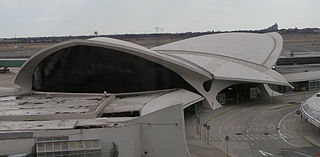
Thin-shell structures are lightweight constructions using shell elements. These elements, typically curved, are assembled to make large structures. Typical applications include aircraft fuselages, boat hulls, and the roofs of large buildings.
Vector Foiltec is a business using transparent plastic (ETFE) cushions filled with air as an architectural cladding technology. This solution can be better than glass panels in applications such as roofs over aggressive environments where chemicals would attack a metal window frame, or where the transparent panels have to accommodate deformation due to changing thermal conditions.
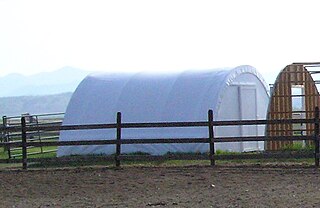
Tension fabric buildings are constructed using a rigid frame—which can consist of timber, steel, rigid plastic, or aluminum—and a sturdy fabric outer membrane. Once the frame is erected, the fabric cover is stretched over the frame. The fabric cover is tensioned to provide the stable structural support of the building. The fabric is tensioned using multiple methods, varying by manufacturer, to create a tight fitting cover membrane.
A fabric structure is a structure made of fabric, with or without a structural frame. The technology provides end users a variety of aesthetic free-form building designs. Custom-made structures are engineered and fabricated to meet worldwide structural, flame retardant, weather-resistant, and natural force requirements. Fabric structures are considered a sub-category of tensile structure.
Taiyo Kogyo Corporation, based in Tokyo and Osaka, Japan, is a specialty contractor for the design, engineering, fabrication and installation of tensile membrane structures.
Geiger Engineers is an American structural engineering consulting firm located northwest of New York City. Founded in 1988 by David H. Geiger, the company has worked on large projects throughout the world. Building from a solid foundation in long span and tensile membrane structures, Geiger Engineers has branched out over the years into a range of specialties from designing sports facilities to providing engineering services for the entertainment industry.



















